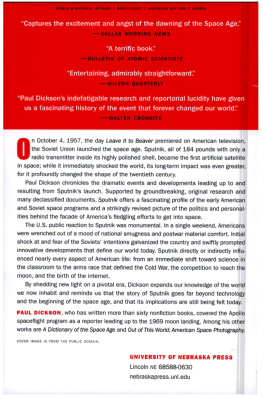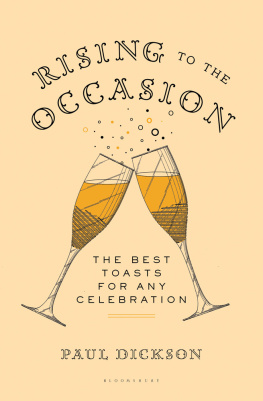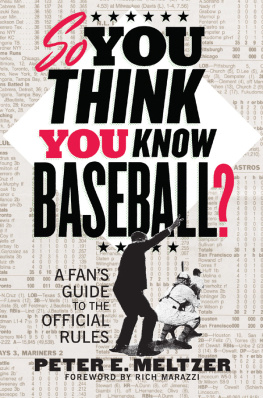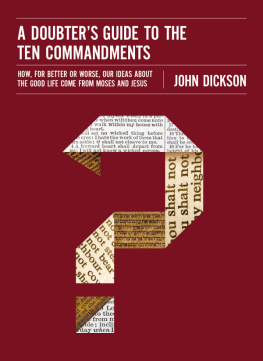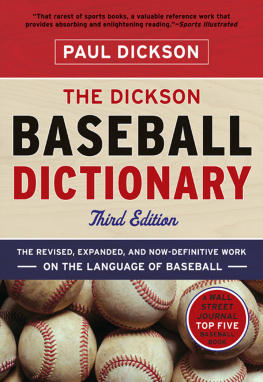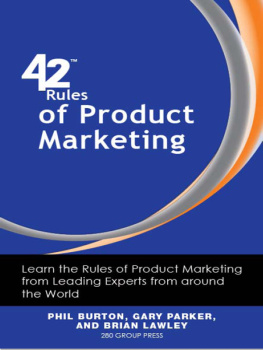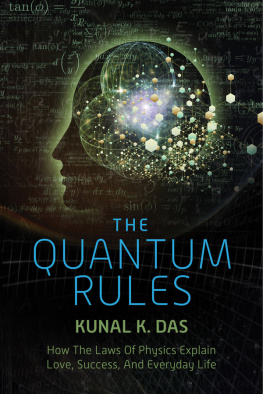THE
OFFICIAL
RULES
5,427 Laws, Principles, and Axioms
to Help You Cope with Crises,
Deadlines, Bad Luck,
Rude Behavior, Red Tape,
and Attacks by Inanimate Objects
PAUL DICKSON
DOVER PUBLICATIONS, INC.
Mineola, New York
To the fellows of the Murphy Center, and especially Martha Moutray for first seeing the possibilities of serving humanity with its own set of rules and to Jack Limpert for keeping the idea alive for a decade in the pages of The Washingtonian Magazine.
Copyright
Copyright 1979, 1980, 1989, 1996, 1997, 2000, 2011, 2013 by Paul Dickson
All rights reserved.
Bibliographical Note
The Official Rules: 5,427 Laws, Principles, and Axioms to Help You Cope with Crises, Deadlines, Bad Luck, Rude Behavior, Red Tape, and Attacks by Inanimate Objects is a new work, first published by Dover Publications, Inc., in 2013.
Library of Congress Cataloging-in-Publication Data
Dickson, Paul.
The official rules : 5,427 laws, principles, and axioms to help you cope with crises, deadlines, bad luck, rude behavior, red tape, and attacks by inanimate objects / Paul Dickson.
pages cm.
Summary: According to Murphys Law, If anything can go wrong, it will. This humorous hardcover compilation offers a wealth of variations on the well-known adage, including maxims related to business matters, excuses, efficiency, and legal jargon. It also features a Bureaucratic Survival Kit, Old Saws Resharpened, How to Tell the Difference Between Democrats and Republicans, and other comic truthsProvided by publisher.
eISBN-13: 978-0-486-79717-5 (hardback)
1. American wit and humor. I. Title.
PN6162.D4885 2013
818'.540208dc23
2013008655
Manufactured in the United States by Courier Corporation
48210301 2013
www.doverpublications.com
Contents
Special Sections:
All things are subject to fixed laws.
Marcus Manilius, Astronomica, I, c. 40 B.C.
Natural laws have no pity.
Longs 22nd Note, from Robert A. Heinleins Time Enough for Love
If you know a good story, tell it from time to time.
McCabes Law
Turn off the TV and computer and exercise your mind with a good book.
Fortune cookie message obtained in Duxbury, Massachusetts, on August 19, 2009.
Arms of the Murphy Center
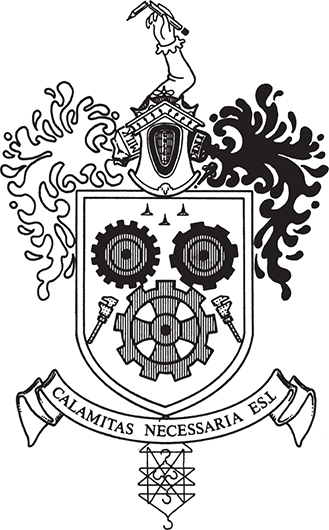
Arms: Gules three mismatched cogwheels, or two monkey wrenches salient, or three tack caltrops rampant.
Crest: An arm dressed, holding a broken pencil proper; spilt milk and India ink mantling.
Motto: Calamitas Necessaria Est (Disaster Is Inevitable).
Preface
For centuries mathematics and the pure sciences held a seemingly unbreakable monopoly on natural laws, principles, and named effects. At the gradual pace of a law at a time, researchers and scholars worked to show us that some element of the universe was working in perfect accord with an immutable rule that, in its purest form, could be stated without taking a breath.
The Second Law of Thermodynamics, for instance, told us that in every energy transaction some of the original energy is changed into heat energy, while Boyles Law informed us that at a constant temperature the volume of a given quantity of gas is inversely proportional to the pressure on the gas. Hundreds and hundreds of laws were created, with most of the great names in science in possessive possession of at least one solid law (e.g., Newtons, Ohms, Darwins, Mendels, Archimedes, Einsteins, and so forth). To get through four years of college (let alone four years of Sunday crossword puzzles) one is forced into contact with a few score such laws, which are liable to range from the Law of Action and Reaction to the Laws of Vibrating Strings.
Yet as new laws were discovered, posted, and accepted by the textbook publishers, people outside the hard sciences increasingly felt that a whopping injustice was in force. Not only were the soft sciences, humanities, and workaday pursuits excluded from the business of lawmaking buteven more to the pointthere was a deep and demonstrable prejudice at work as all these big-name scientists were busy describing a perfect Universe when, as everyone else (including the not-so-big scientists) was fully aware, it is not all that perfect.
Over the years, there were a few exceptions. Economists were able to gain acceptance for such items as the Law of Supply and Demand: As demand increases the price goes up which attracts new suppliers who increase the supply bringing the price back to normal, and Says Law: Supply creates its own demand. But these were exceptions to the rule. Then in the years after World War II, more and more people began hearing series of lawsmore often said than writtenattached to such names as Murphy, Finagle, and Sod, which had an uncanny ability to describe things as they could be and often werescrewed up, dysfunctional. Murphy looked right into our lives and concluded, If anything can go wrong, it will, and Finagle was able to perceive via his Fourth Law: No matter what occurs, there is always someone who believes it happened according to his pet theory. It cannot be proven, but it has been suggested that Murphy, Finagle, and their disciples (all to be discussed in the pages ahead) have helped more people get through crises, deadlines, bad days, the final phases of projects, and attacks by inanimate objects than either pep talks, uplifting epigrams, or the invocation of traditional rules. It is true that if your paperboy throws your paper in the bushes for five straight days, it can be explained by Newtons Law of Gravity. But it takes Murphy to explain why it is happening to you.
As these explanations of the perversity of nature grew in popularity and importance, other laws and principles came along to explain how other things worked. In 1955 an obscure historian named C. Northcote Parkinson wrote an article called Parkinsons Law, in which he showed that Work expands so as to fill the time available for its completion. Parkinson became famous, and his law has become a permanent tenet of organizational life. Parkinson begat more laws as others brought out their own discoveries. Some were highly successful, such as Dr. Laurence J. Peter and his famous Peter Principle (1969), while others created laws that only those in a specific circle could fully appreciate, like the great body of laws created by and for computer programmers. By the early 1970s laws were coming in from all over and showing up everywhere: newspaper columns, books, laboratory and lavatory walls. What more and more people were discovering in their own lives and jobs are those universal truths which have been begging to be stated scientifically and shared with the rest of the world. In most cases these laws are being discovered by average, not famous men and womenalthough nothing prevents senators, scientists, press pundits, and other VIPs from getting into the act. Yet, regardless of whether a law is discovered by a Nobel Laureate or an insurance company clerk, a good law is a good law and able to move around the country with remarkable speed. Unfortunately, a law often moves so quickly that it is soon separated from the person who discovered and named it.
As a result an important new law like Anthonys Law of Force which says, Dont force it, get a larger hammer, is known far and wide to people who have no idea who Anthony is.
Often a group of a dozen or so new laws are collected and typed out on a sheet of paper. These sheets are drawn to copying machines like metal filings to a magnet, and once copied are posted on bulletin boards, passed out at water coolers, dropped into inter-office mail systems, and swapped at conventions. Whether by jet, teletype, or mail, a list compiled and copied in Boston on a Monday is liable to show up in Santa Monica by the end of the week. The creation and distribution of laws has become a full-fledged cultural phenomenon: a computer-age folk idiom.
Next page



